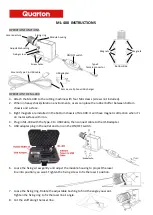
Hydraulic connection of the CMP
Notes on pipes and hoses
In order to keep the pressure loss as low as possible, use as few threaded
connections as possible.
The pressure loss in a hydraulic line depends upon:
•
Flow rate
•
Kinematic viscosity
•
Pipe dimensions
•
Fluid density
The pressure loss can be estimated for hydraulic oils as follows:
Δp ≈ 6.8 * L / d
4
* Q * V * D
Δ
p
= Pressure differential in [bar]
L
= Pipe length [m]
d
= Internal pipe diameter [mm]
Q
= Flow rate [l/min]
V
= Kinematic viscosity [mm²/s]
D
= Density [kg/dm³]
Mineral oil-based hydraulic fluid has a
density of ≈ 0.9
kg/cm³.
This applies to straight pipe lines and hydraulic oils. Additional threaded
connections and pipe bends increase the pressure differential.
Keep the height difference between the pump and the oil level in the tank as
low as possible.
Hoses must be suitable for suction pressures of at least -0.5 bar.
Constrictions in the connections and lines should be avoided. This could
compromise suction output and cause cavitation .
Note that the nominal size of the connected hoses/piping must be at least as
large as the cross-section of the INLET connection.
Make sure that no tension or vibrations are carried over to the pump or filter
housing when the pipes are connected. Use hoses or expansion joints if
necessary.
CMP43x0-5-…
en(us)
Page 23 / 40
MoWa CMP43x0-5 4191543b en-us 2018-02-20.doc
2018-02-20
















































